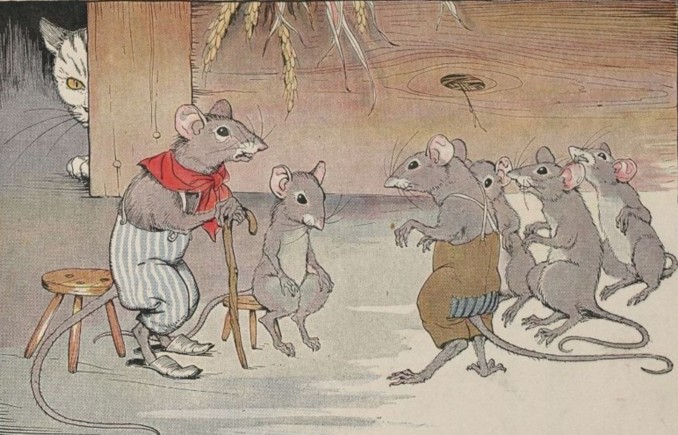PART A_1
Let’s learn vocabulary. Listen and repeat the words and the sentences with your tutor.
PART A_2
| 1. constant | /KON-stuhnt/ |
| -not changing or varying | |
| Her mother is her constant companion. | |
| 2. dare | /dair/ |
| -to have the necessary courage or boldness for something | |
| She dared to quit her job. | |
| 3. stir | /stur/ |
| -to move around, especially briskly; be active | |
| Some park goers stir around the park. | |
| 4. successful | /suhk-SES-fuhl/ |
| -achieving or having achieved success | |
| He wants to be a successful businessman in the future. | |
| 5. arise | /uh-RAHYZ/ |
| -to get out of bed | |
| We arose early on Christmas morning. |
PART B_1
Let’s read the story. Please read it aloud, and I will check your pronunciation and intonation.
PART B_2
BELLING THE CAT

The Mice once called a meeting to decide on a plan to free themselves of their enemy, the Cat. At least they wished to find some way of knowing when she was coming, so they might have time to run away. Indeed, something had to be done, for they lived in such constant fear of her claws that they hardly dared stir from their dens by night or day.
Many plans were discussed, but none of them was thought good enough. At last, a very young Mouse got up and said:
“I have a plan that seems very simple, but I know it will be successful. All we have to do is to hang a bell about the Cat’s neck. When we hear the bell ringing we will know immediately that our enemy is coming.”
All the Mice were much surprised that they had not thought of such a plan before. But in the midst of the rejoicing over their good fortune, an old Mouse arose and said:
“I will say that the plan of the young Mouse is very good. But let me ask one question: Who will bell the Cat?”
It is one thing to say that something should be done, but quite a different matter to do it.
PART C_1
Let’s answer comprehension questions. Please answer them based on the story.
PART C_2
| 1. | What animal is the enemy of the mice? |
| 2. | What was their plan? |
| 3. | What did the Old Mouse ask? |
PART D_1
Let’s discuss the story. Please answer the questions below and express your opinions.
PART D_2
| 1. | Do you agree that their plan was great? |
| 2. | Do you think it is right to celebrate before carrying out a plan? |
| 3. | How do you think the mice could finally get rid of the Cat? |
| 4. | The fable’s lesson is “It is one thing to say that something should be done, but quite a different matter to do it.” Do you agree with this? Why or why not? |
| 5. | Do you remember any personal experiences similar to the story? Please share. |
REVIEW AND FEEDBACK
Now, let us review the things that you learned in this lesson.
ではこのレッスンで学んだことを振り返りましょう。
(Please give a short feedback on how your student did in your class.)
| Grammar 文法 |
Pronunciation 発音 | Vocabulary 単語 |
Comprehension 理解 |
|
|---|---|---|---|---|
 GOOD GOOD |
文法の誤りはほとんどなく、完全な文章で話すことができる | ほとんどの単語をはっきりと正しく発音することができる | 習った表現を適切に使うことができる | 文章を理解し、質問に正しく答えることができる |
 FAIR |
文法の誤りはあるが、完全な文章で話すことができる | 発音の練習が必要な言葉がいくつかある | たまにミスはあるが、習った表現を適切に使うことができる | 文章を完全に理解するのは難しく、質問に正しく答えられないときもある |
 POOR |
文章で話すのは難しく、単語だけで話すことができる | 発音の練習が必要である | 習った単語と表現を少しだけ使うことができる | 文章を理解するのは難しく、質問に答えるのは難しい |
Parts of this lesson material are based on:
An eBook from The Project Gutenberg.
This eBook is for the use of anyone anywhere at no cost and with almost no restrictions whatsoever. You may copy it, give it away or re-use it under the terms of the Project Gutenberg License included with this eBook or online at www.gutenberg.org
An eBook from The Project Gutenberg.
This eBook is for the use of anyone anywhere at no cost and with almost no restrictions whatsoever. You may copy it, give it away or re-use it under the terms of the Project Gutenberg License included with this eBook or online at www.gutenberg.org